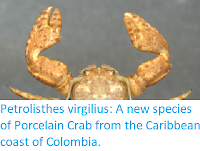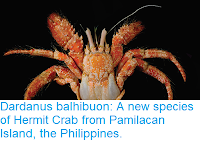Squat Lobsters of the family Munididae are recognised by the trispinose or trilobate front, usually composed of a slender rostrum flanked by supraorbital spines. The Munididae is one of the most diverse of families of Anomuran Decapods, containing 21 genera and more than 400 species distributed in the Atlantic, Indian, and Pacific oceans, from the coastal area to the abyssal plain. Among these genera, the genus Paramunida was proposed based on the presence of spinules or granules densely covering the carapace dorsally (rather than transverse ridges), the short undeveloped rostrum, the antennal peduncle with a well-developed anterior prolongation of article 1, and the absence of the first pair of male gonopods. The genus Hendersonida was proposed for one species, Paramunida granulata, which is widely distributed from the Philippines to Polynesia. Hendersonida is closely related to the genus Paramunida. The two genera show genetic divergence values higher than expected between species, and within the range observed between other genera of Munidid Squat Lobsters. They can also be morphologically differentiated by differences in the spinulation of the carapace and the length of the distomesial spine of the antennal article 2.
In a paper published in the journal ZooKeys on 21 May 2020, Paula Rodríguez-Flores of the Centre d’Estudis Avançats de Blanes and the Museo Nacional de Ciencias Naturales, Enrique Macpherson, also of the Centre d’Estudis Avançats de Blanes and Annie Machordom also of the Museo Nacional de Ciencias Naturales, describe a new species of Hendersonida from two specimens collected during a recent expedition to Papua New Guinea in August-October 2010.
The new species is named Hendersonida parvirostris, where 'parvirostris' derives from the Latin, 'parvus' little, and 'rostrum', in reference to the small size of the rostral spine. The species is described from two specimens, both female, collected using beam trawls in August-October 2010 BIOPAPUA expedition to Papua New Guinea. Both specimens are deposited in the collections of the Muséum national d’Histoire naturelle in Paris.
Hendersonida parvirostris dorsal view of ovigerous female holotype, 8.9 mm (MNHNIU-2011-4498), Papua New Guinea. Rodríguez-Flores et al. (2020).
The carapace of Hendersonida parvirostris is slightly broader than long; the dorsal surface is covered with numerous granules and few scattered minute spines, with few short simple setae; the epigastric region has a row of 6 minute spines; the mesogastric region is slightly convex, and unarmed; the cervical grooveis distinct; the cardiac and anterior branchial regions slightly circumscribed; the cardiac region has an anterior transverse row of four minute spines, and two minute spines posterior to it; each branchial region has 2–4 small spines near the lateral borders; the frontal margin is slightly concave; the lateral margins convex; an anterolateral spine reaches sinus between the rostral and supraocular spines. The rostrum is very short; the supraocular spines are longer the than rostrum, each spine has an additional small lateral spine; the margin between the rostral and supraocular spines is concave.
The sternites (sternum sements) have numerous arcuate striae; the width of sternite 3 is less than half the width of sternite 4, the anterior margin is nearly straight; sternite 4 has an anterior margin moderately elongate, narrowly contiguous to sternite 3; sternite 7 has numerous granules.
Somites 2 and 3 of the abdomen each have some small or moderate–sized spines on the anterior and posterior ridges, two median spines are larger than others; the posterior ridge of somite 4 is without a distinct single median spine.
The eyes are large, and much wider than the eyestalk.
Article 1 of the antennule (the smaller of two pairs of antennae) barely exceeds the corneae, with a distomesial spine slightly shorter than distolateral; and roughly twice as long as wide; the lateral margin is without a fringe of long setae, with a distal slender portion roughly half as long as the proximal inflated portion.
The anterior prolongation of article 1 of the antennae overreaches antennular article 1 by about one-fourth of its length; article 2 is shorter than article 3 and slightly longer than wide, the ventral surface has small scales; the distomesial spine well is developed, reaching end of article 3, and clearly not reaching midlength of anterior prolongation of article 1, the distolateral angle is unarmed; article 3 is twice as long as it is wide, and unarmed.
The ischium of maxilliped 3 (i.e. the third mouth appendage) is 1.5 times the length of the merus measured along the dorsal margin, distoventrally it bears one spine; the merus has two or three small spines on the flexor margin, the extensor margin has a distal spine.
Pereopod 1 (the first leg) is lost in the holotype, and only the ischum and merus (i.e. the forst two segments) are preserved in the paratype. The merus is 2.5 times the carapace length, and about 15 times longer than high, with a row of spines along the mesial margin.
Pereopods 2–4 are similar, long and slender, with minute granules and short scales on the ventrolateral sides of the meri, carpi and propodi; scales with short setae; the extensor and flexor margins have numerous long plumose setae; pereopod 2 is 6.0 times the carapace length, the merus is 3.0 times longer than carapace, and about 25 times as long as wide, 1.8 times as long as the propodus; the propodus is 20 times as long as wide, and 1.7 times the dactylus length; the merus has well-developed spines along the extensor border, the flexor margin has few spines; the carpus has a distal spine on the extensor and flexor margin; the propodus has some small movable spines along the flexor margin; the dactylus is slightly curved, with a longitudinal carinae along the mesial and lateral sides, the ventral border, under the flexor margin, is unarmed; pereopods 3 and 4 are of similar length to pereopod 2, with similar spinulation and segment proportions.
The base colour of carapace is light orange, the gastric region reddish; the granules and spines are orange. The rostrum and supraocular spines are reddish. Abdominal somites 1–4 are light orange, with scales and granules that are orange or reddish; somites 5 and 6 and the telson are whitish. Pereopods 2–4 are light orange, the spines along the flexor margins are reddish, spines along the flexor margins are whitish; the distal portion of meri, carpi, and propodi and proximal part of carpi, propodi, and dactyli with reddish band, and distal half of dactyli are whitish.
The genus Hendersonida was erected for one rare species, Hendersonida granulata which is known from several localities of the western Pacific, and clearly differentiable from all species of the genus Paramunida. The new species, Hendersonida parvirostris, is the second representative of the genus. Both species are morphologically and genetically separated from all the species of Paramunida.
Phylogenetic hypothesis based on mitochondrial molecular data (COI and 16S) represented by a tree obtained by Bayesian inference, including Bayesian posterior probabilities. To test the monophyly of Hendersonida, Rodríguez-Flores et al. have included all genetic data available from species of Paramunida (38 species). Rodríguez-Flores et al. have collapsed the Paramunida node to facilitate comparison between genera. Rodríguez-Flores et al. (2020).
Two conspicuous diagnostic characteristics differentiate the Hendersonida genus from Paramunida: the granulated surface of the carapace; and the long distomesial spine of antennal article 2, almost reaching the end of the anterior prolongation of article 1. The morphology of the new species, however, shows that the long distomesial spine of antennal article 2 is not a valid generic character because this spine is moderately short, only reaching the end of antennal article 3, in H. parvirostris. Additionally, in both species the anterior margin of sternite 4 is moderately elongate, narrowly contiguous with sternite 3, whereas this margin is nearly transverse, broadly contiguous with sternite 3, in Paramunida.
See also...
Follow Sciency Thoughts on Facebook.








